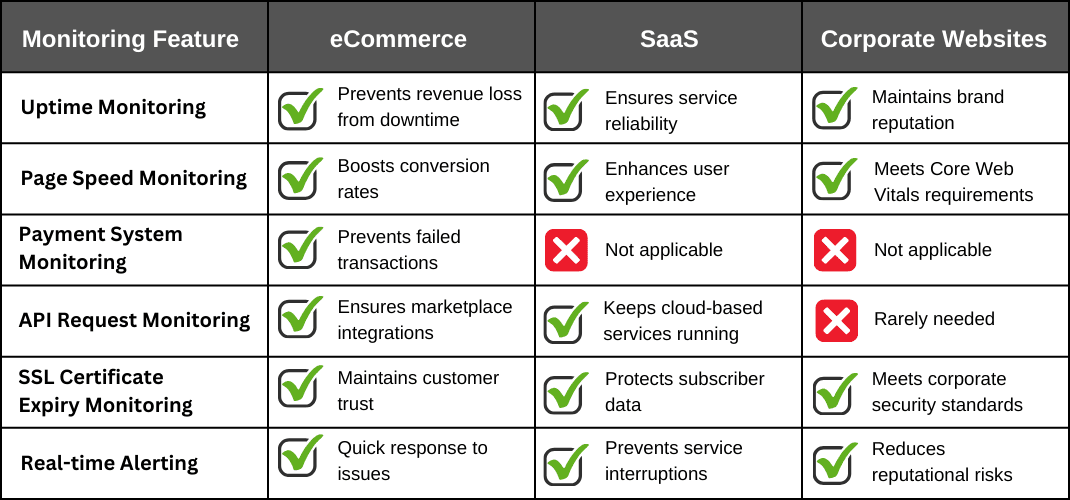In today's digital-first world, website performance is critical for business success. Whether you're running an eCommerce store, a SaaS platform, or a corporate website, ensuring uptime and smooth functionality is essential. Website monitoring helps businesses prevent downtime, optimize performance, and improve user experience. But who exactly needs website monitoring, and why? Let’s explore how different industries leverage monitoring solutions to maintain reliability and drive growth.
Who Benefits from Website Monitoring? How Businesses Use It to Prevent Downtime & Optimize Performance
Nadiia Sidenko
2025-03-11

Who Benefits from Website Monitoring? How Businesses Use It to Prevent Downtime & Optimize Performance
Why Businesses of All Sizes Need Website Monitoring
What is Website Monitoring, and Why is It Essential?
Website monitoring is the process of tracking a website’s uptime, performance, and security in real time. Businesses rely on monitoring tools to detect downtime, slow loading times, or security vulnerabilities before they affect customers. As highlighted in How Regular Monitoring Can Save Your Website from Traffic Drops and Performance Issues, proactive monitoring plays a crucial role in preventing performance issues that could lead to lost visitors and revenue.
The Risks of Website Downtime and Slow Performance
A website outage can lead to lost revenue, frustrated customers, and damage to brand credibility. According to Akamai’s research on the true cost of downtime, even a few minutes of unplanned downtime can result in significant financial losses, especially for eCommerce and SaaS platforms.
Even slow-loading pages can cause a 7% drop in conversions and increase bounce rates. Google’s Core Web Vitals emphasize that improving page speed and responsiveness directly impacts SEO rankings and user engagement. Without proper monitoring, businesses may not detect performance issues until users start complaining, resulting in lost opportunities and reduced customer satisfaction. Some of the most common website monitoring mistakes include not setting up proper alerts, neglecting SSL certificate monitoring, and ignoring mobile performance.
How Monitoring Improves User Experience and Security
Website monitoring ensures that load speeds remain optimal, helping businesses provide a seamless user experience. Google PageSpeed Insights recommends monitoring load times regularly to improve user retention and reduce abandonment rates.
Additionally, security monitoring detects potential cyber threats, such as DDoS attacks. As noted by Cloudflare’s guide to DDoS protection, businesses that fail to monitor traffic in real time are at risk of major security breaches, downtime, and service disruptions.
How Different Industries Use Website Monitoring
Different business types have unique website monitoring needs. Let’s look at how eCommerce, SaaS, and enterprise companies benefit from real-time monitoring solutions.
eCommerce: Preventing Downtime & Ensuring Smooth Transactions
Why Uptime is Crucial for Online Stores
For eCommerce businesses, every second of downtime means lost sales. A website outage during peak shopping hours can result in thousands of dollars in lost revenue. As explained in Why Proactive Monitoring is the Hero of Website Optimization and SEO Performance, proactive monitoring can help online stores prevent costly downtime by detecting potential issues before they escalate.
How Monitoring Helps Prevent Payment Failures and Cart Abandonment
Slow page loads or payment gateway failures frustrate customers, leading to abandoned carts. Statista’s data on global cart abandonment highlights that high abandonment rates are often linked to checkout issues and slow website performance. Monitoring tools detect these issues in real time, allowing businesses to take immediate action.
SaaS Companies: Ensuring Reliable Service for Customers
The Importance of Uptime for Subscription-Based Services
SaaS platforms operate on recurring revenue models, meaning service disruptions directly impact customer retention. Downtime can lead to canceled subscriptions and reputational damage.
How Proactive Monitoring Prevents API Failures
Most SaaS products rely on APIs for functionality. Website monitoring helps detect API failures, preventing disruptions and ensuring seamless integration with third-party services.
Corporate & Enterprise Websites: Protecting Brand Reputation
Why Corporations Need Real-Time Website Monitoring
Large enterprises manage complex websites with high traffic volumes. Website monitoring ensures server stability, uptime tracking, and content availability for users worldwide.
How Domain and SSL Monitoring Safeguard Brand Credibility
Expired SSL certificates or domain expiration issues can damage a company’s trustworthiness. Website monitoring tools send alerts when a domain or SSL certificate is about to expire, preventing unexpected disruptions. Understanding key components of a website monitoring strategy is essential for building a strong security and performance plan.
Table: Essential Website Monitoring Features for Different Business Types

Understanding the Table:
Website monitoring needs vary depending on the type of business. For eCommerce websites, uptime and payment system monitoring are critical to prevent revenue loss and abandoned carts. SaaS companies rely heavily on API monitoring and real-time alerts to ensure seamless service for their customers. Corporate websites prioritize brand reputation, security compliance, and SSL certificate validity.
This table highlights the key monitoring features essential for each industry, helping businesses choose the right tools to enhance performance, security, and user experience. By understanding these differences, companies can optimize their monitoring strategy to prevent downtime, maintain trust, and improve operational efficiency.
Case Studies: How Businesses Improved Performance with Website Monitoring
Real-world examples highlight how businesses leverage monitoring solutions to optimize website performance.
Case Study 1: How Adidas Enhanced E-Commerce Performance with Kubernetes
Adidas transitioned its entire e-commerce platform to Kubernetes, achieving significant improvements in website performance and deployment frequency. This migration led to a 50% reduction in load times and enabled the company to increase release cycles from every 4-6 weeks to 3-4 times daily.
Case Study 2: How Slack Reduced API Failures with Real-Time Alerts
Slack, a leading SaaS communication platform, depends on seamless uptime for its millions of users. After experiencing multiple API failures that disrupted workflows, Slack integrated automated monitoring and real-time alerts to detect issues before they escalated. This proactive approach helped the company reduce service disruptions and improve reliability, ensuring that users experience minimal downtime.
Case Study 3: How ASOS Improved Observability to Reduce Mean Time to Resolution (MTTR)
ASOS, a leading online fashion retailer, implemented Grafana Cloud to enhance real-time troubleshooting capabilities. This observability upgrade allowed ASOS to detect and address issues more swiftly, ensuring a seamless customer experience and reducing MTTR.
Choosing the Right Website Monitoring Tools for Your Business
What Features to Look for in a Monitoring Solution
Selecting the best website monitoring tool depends on business needs. Key features include:
- Uptime monitoring to track availability and detect outages before they impact users.
- Performance monitoring to optimize load speeds and improve Core Web Vitals metrics.
- Security monitoring to detect vulnerabilities, such as SSL expiration or DDoS attacks.
- API and transaction monitoring for SaaS and eCommerce platforms to ensure seamless user experiences.
One of the most comprehensive solutions available is MySiteBoost, which provides real-time uptime tracking, advanced performance analytics, automated security checks, and instant alerts. With multi-channel notifications and proactive monitoring, MySiteBoost helps businesses prevent downtime, optimize speed, and enhance security effortlessly.
For an in-depth guide on how monitoring tools impact SEO and conversions, check out The Guide to Website Monitoring Tools.
Final Thoughts
Website monitoring is no longer an option—it is a business necessity. Whether you manage an eCommerce store, a SaaS platform, or a corporate enterprise, proactive monitoring ensures:
- Higher uptime and performance stability
- Better SEO rankings and enhanced user experience
- Increased revenue by preventing lost transactions
- Stronger security protection against cyber threats
Recent industry reports highlight that businesses that invest in proactive monitoring experience lower operational risks and increased revenue growth. According to Gartner’s insights on IT automation, by 2024, advancements in analytics and automated remediation will reduce the need for manual IT operations by 30%, leading to more efficient incident response. Additionally, Gartner predicts that 40% of product and platform teams will integrate AIOps for automated change risk analysis, reducing unplanned downtime by 20%. These findings demonstrate that implementing proactive monitoring and automation strategies significantly enhances operational efficiency and customer satisfaction.
Similarly, Forrester’s 2024 US Customer Experience Index Rankings highlights that organizations focused on enhancing customer experience achieve 51% higher customer retention rates compared to those that do not prioritize customer-centric strategies. This underscores the importance of investing in performance monitoring tools, as they contribute to a seamless digital experience, improving customer satisfaction and long-term engagement.
While some myths suggest website monitoring is only for large enterprises, Debunking Myths About Website Monitoring clarifies how companies of all sizes benefit from real-time tracking and automated alerts.
By adopting a reliable monitoring solution, businesses can ensure their website is always available, fast, and secure—all of which contribute to higher customer trust and long-term success.
Looking for the best website monitoring tools? Start with proactive monitoring today to keep your business online and running smoothly!
Who Benefits from Website Monitoring? How Businesses Use It to Prevent Downtime & Optimize Performance
Why Businesses of All Sizes Need Website Monitoring
How Different Industries Use Website Monitoring
Case Studies: How Businesses Improved Performance with Website Monitoring
Choosing the Right Website Monitoring Tools for Your Business
Final Thoughts